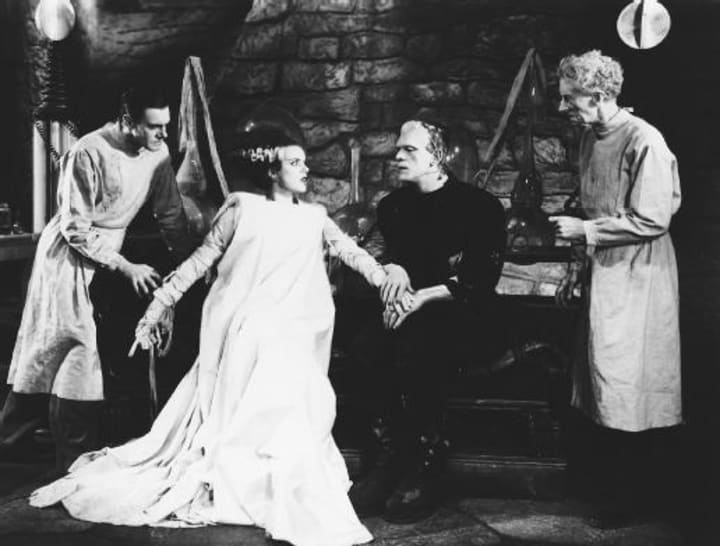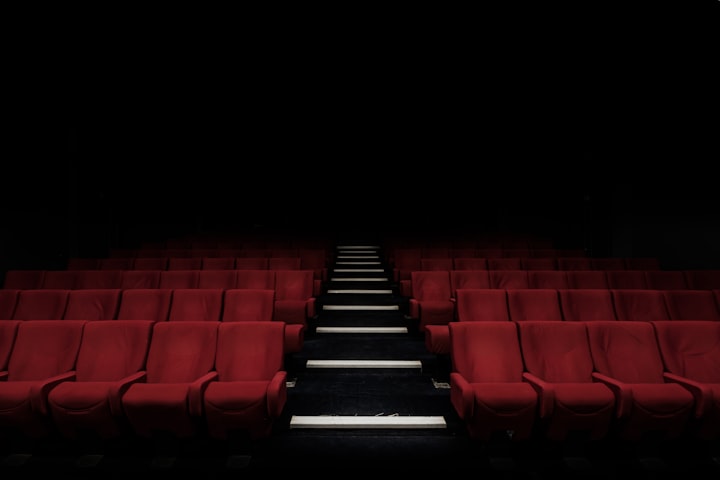
I first saw the Bride of Frankenstein as a child, on a black-and-white tube television set while living on a military base in a foreign country. I don't know if it was Halloween time or not (I don't now remember), but the Armed Forces Radio and Television Station (A.F.R.A.T.S. is the acronym. Of course, those letters can be rearranged to make a much more humorous acronym) sure as hell wasn't going to spring for the rights to play any horror flick that wasn't fifty years old; or one that might, just might I say, contain some sort of subversive content. Of course, Bride of Frankenstein does contain subversive content, but the Army broadcasters, as well as the audiences of the period, never even realized it.
Bride begins with a scene from the early Nineteenth-century sitting room of Lord Byron (Gavin Gordon). Seated with him, as a maid takes the hounds out of the room, is Percy Shelley (Douglas Walton) and lover Mary, who authored Frankenstein. This is of course the beautiful, pixieish Elsa Lanchester, in her famous dual role.
The very first lines, intoned by the excellently, weirdly, creepily rakish Byron is that he should like to think of the lightning bolts coming "from an irate Jehova!" That they were all "aimed at the head of George Gordon Lord Byron, England's greatest sinner!"
This lends an ominous opening chord to the rest of the film, the subtext of which is the spiritual exile of a man and his mate, both sprung from the clutches of death, both crafted by the hands of veritable necromancers, blasphemers who dare tamper with the forces of Nature; that is to say, to defy the holy order of things and to take for themselves the power, in a Promethean sense, of an all-powerful God. (But, I am getting ahead of myself.)
Byron observes that Mary has written a tale that "freezes his blood," about a man stitched together from bodies, from "pieces of cadavers rifled from graves."
We journey back, or rather forward, from the early nineteenth century to an anachronistic 1931, with scenes from the original Frankenstein. Henry and Fritz (Colin Clive and Dwight Frye) in the graveyard opener, stealing a body. We see the climax and final scenes of the burning windmill (fiery cross?), and then we are sent to the present, where the crowd of angry peasants of Vasaria is gathered at the ruins of the mill. Hans (Reginald Barlow), the father of the little girl that the Monster (Boris Karloff) inadvertently drowned in the last film, goes below the ruins, into a subterranean lake, to confirm for himself that his daughter's killer is truly dead.
Bad move. The Monster is, in point of fact, NOT dead. He emerges from the brackish water, like a lurking croc, and dispatches the man. Making his way to the surface, he encounters Minnie (Una O'Connor), the cockney comic relief of so many of these movies, dressed in Victorian fashion with a comb and ribbons flowing from her hair.
She bolts back to the castle.
There, Henry (Colin Clive) has been carried back, still alive, to convalesce. He is joined by his fiance Elizabeth (Valerie Hobson), (and, we rather thought this all resolved by the end of the first film), but Henry needs be revived and cared for yet again, all the while lamenting his "mad dream" of tampering with that which God has reserved for Himself.
It isn't long before the cadaverous mad scientist Dr. Pretorius (Ernest Thesiger) comes calling, (on the proverbial "dark and stormy night") to give Henry an offer he can't refuse. Or, at the very least, dare not to.
The weird, skeletal creep takes Henry back to his lab, where he shows him several humorous homunculi (i.e. miniature humans) in glass jars; these he has "grown, like germ cultures." They are dressed and perform as king, queen, ballerina, and devil. At this point, we realize that we are dealing with a clever satire.
Meanwhile, the Monster is chased down by the ever-ready mob of angry peasants. Trussed up in a crucifix pose, he is brought back to a dungeon and chained to a chair. It is no time, however, before he escapes from this, and is back to tramping through the forest, finally happening upon the hut of a blind hermit (O.P. Heggie) playing violin.
Sharing food and drink, and even smokes (the Monster does fear the fire of a match), the Hermit cannot see the Monster, so is not frightened. It is not until two unthinking rubes (one of them a small uncredited part played by John Carradine) happen upon the scene that he is alerted. All havoc breaks loose, the hut goes up in flames, and the monster tramps back out into the woods.
Pretorius essentially forces Henry into complying with his wishes to create for the Monster a female mate. To this end, he kidnaps Elizabeth (or rather, has the Monster do so), and holds her captive. Beforehand, while rifling graves with two helpers, he stops to have a drink and a quick meal on top of a coffin, in a crypt. Here, the Monster finds him, and the audience realizes how mad, wicked, and seemingly close to death, to the dead, Pretorius truly is.
Things build to the "dark and stormy night," yet again. (Note: this particular cliche phrase was first penned by author Bulwer-Lytton in the late Eighteen hundreds.) Henry, at first reticent to create life yet again, to further add insult to his blasphemous injury upon God, nonetheless finds himself warming to his work. Kites are sent aloft, to capture the lightning bolts and send the electricity down to the arcane apparatus that will imbue the Bride with horrific, unholy life. Of course, Dwight Frye ("Karl") is on hand, on the roof of the tower laboratory, to oversee things and then be killed, once again, by the Monster.
The Bride is brought to hideous life; surrounded on both sides by Thesiger and Clive, she wobbles on her feet unsteadily. The lovely, weird and iconic image of Elsa Lanchester here is presented as a light-and-shadow show of haunting, sepulchral, and ghost-like beauty.

"We Belong DEAD!"
The Monster comes forward, wanting to be friends. The Bride rejects him, hissing (Lanchester claimed she mimicked the hissing of a duck when feeling threatened by a predator). The Monster, aghast with rejection and despair, growls, "You hate me, like others!" in his weird, broken English. Going toward the destruct mechanism conveniently placed in the wall, he tells Henry and Elizabeth, "You go! We belong...dead!" The Bride hisses yet again, her face lit eerily from beneath, and Henry and Elizabeth flee while the tower laboratory explodes behind them. Fin.
Decades ago, while at Ball State University, I saw The Bride of Frankenstein at Pruiss Hall, on the big screen, as part of a "Monster Film Series" that included the original Frankenstein (1931), as well as The Mummy (1932) and Gods and Monsters (1998), the film about Bride director James Whale. (Also played that year were the original Nosferatu (1922) and The Cabinet of Dr. Caligari (1917), both with live piano accompaniment.)
Watching Bride on the big screen, you got a feeling for why these films, with their weird, stark landscapes of barren trees, flat fields, craggy peaks, and dark, matte-painted skies, looked as they did. Never meant to be viewed on a small television screen, which they inevitably, invariably were and still are, they drew you into an alternate world, a gothic nightmare planet perched somewhere between the haunted imaginings of the filmmakers and the cinematic world of the early Depression era. It was its own stylistic customizing of the gothic themes proffered in the works of Shelley and Stoker, but vidied through the lens of the still-emerging artform of modern cinema.
But what does Bride of Frankenstein mean?
The subtext is subversive, subtly mocking religion at several turns. The Monster, a creature stitched together from the dead flesh (read "soulless") bodies of deceased men, is trussed up in a Christ-like pose; the shambling, barely articulate man-child then goes to the hut of a monk-like, hermit-like character, breaking bread and drinking wine (communion?), before being driven away by fire--fire being Promethean, of Prometheus who stole the fire and raised the ire of Jupiter, the possessor and thrower of the lightning bolt.
There is further Christian imagery presented slyly, as if to suggest that "God is not to be mocked" by the presence of the Monster, or the discovery of his mad creator Henry. Alternately, it could serve as a subversive mockery of religion and the Christ story itself, as the Monster, a profane being, is resurrected by a man, a scientist, and not Jehova-God.
The work of Frankenstein, its essential theme, is the damnation of a soul, touched by death, born from the dead. The Mephistophelian bargain Frankenstein enters into damns him, and leaves the Monster (the "Creature" in the original novel), likewise a damned soul; lost. He is beyond salvation, as only a reanimated, blasphemous thing, risen from the grave. He is, as always, looking not so much for a "Bride," but for his Father.
Queer interpretations are also advanced; as, for instance, the film's relationship between the ambiguously gay Thesiger and Clive (both men were known to be gay, in an era when you remained firmly in the closet). Whale himself was openly gay, and the Monster could well be interpreted a stand-in for a kind of "muted sexuality"; i.e. the rejection by a heteronormative society of a gay man, seen through the lens of social prejudice as a "monster",, a pariah, and cast-off in horror. The denouement of Bride is the rejection by the weird, reanimated feminine Bride of her arranged partner. In the horror of this rejection, now knowing he can never attain the beauty he so longs for and desires, the soft, yielding supernal and unearthly beauty of this feminine, which he must wish to trnsfer to himself, he chooses suicide. "We belong dead!" he growls. And then he pulls the explosive lever.
Whatever the subtext or various interpretations, The Bride of Frankenstein is a masterful, iconic classic of weird angles, wonderful sound and lighting effects (for 1935), pointed satire, and strange, comic-grotesque and gothic imagery that will not fail to deliver the viewer, again and again, to a different, rarer, and more wonderful cinematic nightmare.
About the Creator
Tom Baker
Author of Haunted Indianapolis, Indiana Ghost Folklore, Midwest Maniacs, Midwest UFOs and Beyond, Scary Urban Legends, 50 Famous Fables and Folk Tales, and Notorious Crimes of the Upper Midwest.: http://tombakerbooks.weebly.com






Comments
There are no comments for this story
Be the first to respond and start the conversation.